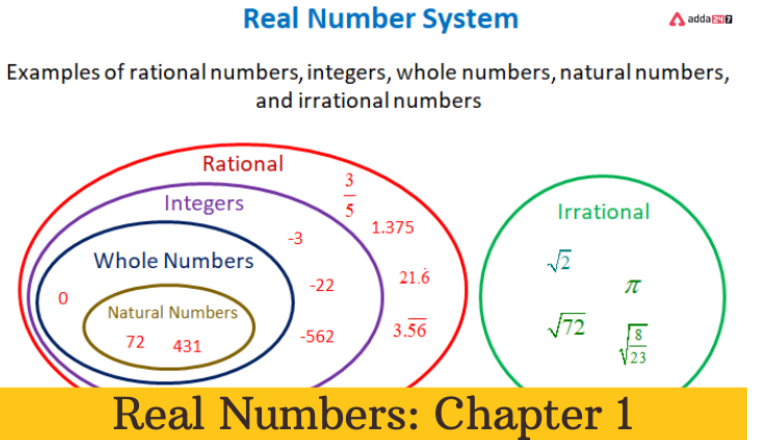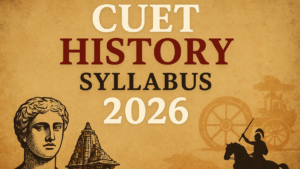Real Numbers Class 10 Notes
R= Real Numbers
Real numbers include both irrational and rational numbers.
I= Integers
Integers are all numbers starting with (…-3, -2, -1, 0, 1, 2, 3…).
Q= Rational Numbers
Rational numbers are real numbers with the pattern p/q, q 0, and p, q I.
- Rational expressions can represent all integers, such as 5 = 5/1.
- Decimal expansion of recurring or non-recurring rational numbers.
Q’ = Irrational Numbers
Real numbers cannot be expressed in the form p/q, whose decimal expansions are non-terminating and non-recurring.
- Roots of primes like √2, √3, √5 etc., are irrational.
N= Natural Numbers
Natural numbers are those that can be counted. N = {1, 2, 3, …}
W= Whole Numbers
Whole numbers are the collective term for zero and all natural numbers. {0, 1, 2, 3,…}
Even Numbers
Even numbers are natural numbers with the form 2n. (2, 4, 6, …}
Odd Numbers
Odd numbers are natural numbers with the form 2n – 1; examples are 1, 3, 5, etc.
- Why can’t the form be expressed as 2n+1?
Remember!
*Natural numbers are exclusively whole numbers.
*Every Whole Number is an integer.
*Rational Numbers are the same as Integers.
*All Rational Numbers are Real Numbers.
Prime Numbers
Prime numbers are all natural numbers bigger than one that can be divided by 1 and the number itself. Examples of prime numbers are 2, 3, 5, 7, and 11.
- Since it only has one factor, 1, it is not a prime number.
Composite Numbers
Composite numbers are any natural numbers that may be divided by one, including the number one itself. Four, six, eight, nine, ten, etc.
- 1 is not a prime number nor a composite number.
Real Numbers Class 10 Notes- Methods
- Euclid’s Division Lemma
There are distinct integers q and r that satisfy the equation a = bq + r, 0 r b when given two positive integers a and b.
Observe this: Every time, “r” is lower than “b.” Each “q” and “r” is distinctive.
- Application Of Lemma
The HCF of two positive numbers is determined using Euclid’s Division Lemma.
Example: How can I find the HCF of 56 and 72?
Steps:-
- Lemma applied to 56 and 72.
- Find “b” and “r” by using a larger number. 72 = 56 × 1 + 16
- Consider 56 as the new dividend and 16 as the new divisor since 16 s not equal to 0. 56 = 16 × 3 + 8
- Once more, if 8 is not equal to 0, apply 16 as the new dividend and 8 as the new divisor. 16 = 8 × 2 + 0
The remainder being zero, (8) is HCF’s divisor
Euclid’s Division Lemma can be extended to all integers except zero, i.e., b 0. This is true even if it is only stated for positive integers.
III. Constructing A Factor Tree
Steps for building a factor tree:
- Put the amount in the form of a prime number plus a composite number.
Example: 48 factorise
- Continue until all primes have been achieved.
∴ Prime factorization of 48 = 24 x 3
- Fundamental Theorem Of Arithmetic
With the exception of the sequence in which they appear, every composite number can be written as a product of primes, and this expression is singular.
Applications:
- In order to find the HCF and LCM of two or more positive integers.
- Demonstrating the irrationality of numbers
- To identify the type of rational number’s decimal expansion.
1. Finding The HCF And LCM Of Two Or More Positive Numbers Using An Algorithm
Step I: The first step is to factorise each of the positive integers that are given and express each as a product of powers of primes that are arranged in ascending order of prime number.
Step II: To determine HCF, locate the least powerful prime factors and multiply them to obtain HCF.
Step III: Find the largest exponent and multiply it by the exponents to determine the LCM.
2. Demonstrating The Irrationality Of Numbers
- Irrational numbers are those whose sum or difference is not rational.
- An irrational number is the product of a non-zero rational number, or its quotient.
3. To Ascertain How Rational Numbers Expand To Decimal Places:
- Let x = p/q, where p and q are co-primes, represent a rational number with an end to its decimal expansion. When m and n are non-negative integers, the prime factorization of “q” takes the form 2m5n.
- If x = p/q is a rational number with p and q being non-negative integers, and q’s prime factorization does not take the form 2m5n, then x has a non-terminating repeated decimal expansion.
Alert!
- 23 can be written as: 23 = 2350
- 52 can be written as: 52 = 2052
Real Numbers For Class 10 Extra MCQ Questions
Ques. The number 7×11×13×15+15 is a
(a) Composite Number
(b) Whole Number
(c) Prime Number
(d) None of these
Ans: (a) and (b) both
Ques. A lemma is an axiom used for providing
(a) other statement
(b) no statement
(c) contradictory statement
(d) none of these
Ans: (a) other statement
Ques. Given that HCF (306,657)=9, find LCM (306,657).
Ans: It is given that the HCF of the two numbers 306,657 is 9. We have to find its LCM.
We know that, LCM×HCF = Product of two numbers. Therefore, LCM×HCF= 306×657
⇒LCM= 306×657/HCF
⇒LCM= 306×657/9
∴LCM=22338
Ques. Prove that 3 + 2√5 is irrational.
Ans: Let 3 + 2√5 be a rational number.
Then the co-primes x and y of the given rational number where (y ≠ 0) is such that:
3 + 2√5 = x/y
Rearranging, we get,
2√5 = (x/y) – 3
√5 = 1/2[(x/y) – 3]
Since x and y are integers, thus, 1/2[(x/y) – 3] is a rational number.
Therefore, √5 is also a rational number. But this confronts the fact that √5 is irrational.
Thus, our assumption that 3 + 2√5 is a rational number is wrong.
Hence, 3 + 2√5 is irrational.
Ques. Check whether 6n can end with the digit 0 for any natural number n.
Ans: If the number 6n ends with the digit zero (0), then it should be divisible by 5, as we know any number with a unit place as 0 or 5 is divisible by 5.
Prime factorization of 6n = (2 × 3)n
Therefore, the prime factorization of 6n doesn’t contain the prime number 5.
Hence, it is clear that for any natural number n, 6n is not divisible by 5 and thus it proves that 6n cannot end with the digit 0 for any natural number n.
Ques. Using Euclid’s Algorithm, find the HCF of 2048 and 960.
Ans. 2048 > 960
Using Euclid’s division algorithm,
2048 = 960 × 2 + 128
960 = 128 × 7 + 64
128 = 64 × 2 + 0
Therefore, the HCF of 2048 and 960 is 64.









 CUET History Syllabus 2026 (Updated), Do...
CUET History Syllabus 2026 (Updated), Do...
 CUET General Test Syllabus 2026 (Latest)...
CUET General Test Syllabus 2026 (Latest)...
 CUET Economics Syllabus 2026, Exam Patte...
CUET Economics Syllabus 2026, Exam Patte...






